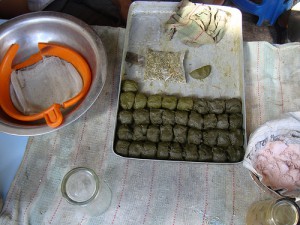 Yesterday’s Nibble about the way a high value-added agrobiodiversity product is produced in the Chu Valley of Kazakhstan…
Yesterday’s Nibble about the way a high value-added agrobiodiversity product is produced in the Chu Valley of Kazakhstan…
It begins with a freshly showered person riding naked for hours on a clean, washed horse inside a two-meter-high “forest” … Afterwards, the human body and that of the horse are covered with a thick layer of resin mixed with sweat. This produces a substance that is usually dark brown in color, which is then thoroughly scraped off the human and horse’s bodies. The mixture is subsequently pressed, molded into bars, and dried.
…elicited from Dirk (on Facebook, via) the observation that in India “they must have a better method to collect concentrate…” The resulting product is shown above, thanks to ezola’s Flickr stream and a Creative Commons license. And thanks to Tom Maisey, and the same source, we can also see how the stuff is marketed in (some parts of) India.
Alas, I could find no conclusive photographic documentation of how they do things in the Chu Valley, although a music video and a movie trailer give some tantalizing hints.
